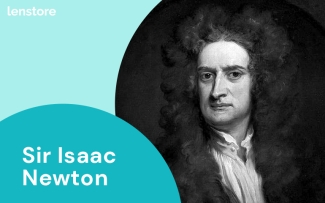Notable figures in eye care - Isaac Newton
Sir Isaac Newton – (1642 - 1727)
Isaac Newton was born in Lincolnshire, England, on Christmas Day, 25th December 1642 (Julian calendar or 4th Jan 1643 - Gregorian). Regarded as a prominent figure in the Enlightenment, Isaac Newton was a natural philosopher whose research touched everything from alchemy and physics to mathematics and optics. The son of a farmer who died before Isaac’s birth, Isaac’s mother remarried but left him to be raised by his maternal grandmother.
Despite his unstable upbringing, Isaac found comfort in attending The King’s School in Grantham, even though he was often noted as being uninterested in his schoolwork. His twice-widowed mother tried to pull him from school to tend the farm. Newton failed miserably at agriculture and returned to complete his studies – this time with the goal of becoming a top student to avoid a return to farm life.
Sensing Isaac’s academic abilities, his uncle convinced Isaac to enrol at the University of Cambridge in 1661. During this time, the Scientific Revolution had taken its grip across European universities, and the work of contemporary philosophers like René Descartes and astronomers like Galileo were being discussed over that than the enduring teachings of Aristotle and Socrates. This modern view of physical reality drew Newton’s attention, and he began his notes titled Quaestiones Quaedam Philosophicae (Certain Philosophical Questions), which revolved around nature and mathematical theories. Newton’s interest in modern learning sidetracked his general studies, which in turn led to Newton graduating in 1665 as an average student without honours or distinctions.
Shortly after his graduation, the university was temporarily closed due to the plague, and Newton returned home to work on his theories about optics, calculus, and physics in isolation. When it reopened, he returned to Cambridge to obtain his Masters and become a Professor of Mathematics.
Newton spent the middle part of his life developing his most noted scientific theories, including the creation of modern calculus, explaining universal gravitation, and outlining his laws of motion (listed in a section below). The findings were documented by Newton in his most notable published works: Philosophiæ Naturalis Principia Mathematica and Opticks.
Newton decided to leave Cambridge for London to take up political ambitions and accepted the position of Warden of the Royal Mint. In 1703, Newton was also elected President of the Royal Society, a title he held until his death. He became interested in theology and wrote several works on his interpretation of the Bible. He spent the remainder of his life in London defending his scientific work and challenging rivals who criticised his findings, a jealous trait that Newton was noted for throughout his lifetime.
In 1727, Newton passed away at the age of 84 at his home in Kensington, London, and was interred with a ceremonial funeral at Westminster Abbey. He was the first scientist buried at the historic church, and his grave is in front of the choir screen near his monument–later unveiled in 1731.

Isaac Newton’s contributions to eye care
Fascinated by the concept of light and optics, in 1672, Newton began his experiments on how the eye perceives light, which eventually culminated in his famous book on Opticks, published in 1704. Here are some of Newton’s findings when exploring his theories on vision:
- Using a prism, Newton discovered that individual light rays refract at different angles, resulting in colour separation. He applied this learning to how the human eye interprets light spectrums.
- To test his theory, Newton inserted a blunt needle in the space between his eye and socket and pressed on it, which resulted in seeing spots. (the same result you can get by poking your eye with your finger).
- Newton assumed that light was formed only of a group of particles, which is incorrect (it is a wave of photons) and was later disproved by Thomas Young.
- Newton’s needle experiment did, however, lead him to the realisation that we see ‘upside-down’ by processing inverted images using the convex shape of the eye’s lens.
Other notable achievements of Isaac Newton
Isaac Newton’s impact on science is immeasurable, and his name is recognised worldwide amongst other greats such as Einstein, Galileo, and Darwin. Some of his most notable and celebrated accomplishments include:
- Discovery of the laws of gravity and theory of universal gravitation. Stating all particles of matter in the universe attract every other particle. This helped explain the orbit of the planets and the influence the moon has on Earth’s Ocean tides.
- Developed Newton’s three laws of motion.
- First law: Law of Inertia – An object at rest remains at rest. An object in motion remains in motion at a constant speed and in a straight line unless a force acts upon it.
- Second law: Law of Acceleration – Force equals mass times acceleration (F=ma)
- Third law: Law of Action and Reaction - For every action, there is an equal and opposite reaction.
- Credited for inventing modern calculus – a mathematical study dealing with continuous change rates.
- Invented the reflecting telescope, which uses mirrors to reflect light and provide a more precise image—an improvement on existing refracting telescopes of the time.
- As a warden of the Royal Mint, Newton redesigned British coins to prevent counterfeiters and invented pressing techniques still used when striking coins today.
- Proposed Newton’s Law of Cooling – which states an object’s heat loss rate is proportionate to the difference in temperature between that object and its surrounding environment.
- Served as a Member of Parliament for Cambridge from 1689 to 1701.
- Elected president of the Royal Society from 1703-1727.
- In 1705, He was the first scientist to be honoured with a knighthood.
Final word
Regarded as one of the most preeminent scientists the world has ever known, Isaac Newton’s studies varied from calculus to cat doors to colour spectrums. While his experiments into eyesight and vision are a lesser-known aspect of his career, he was essential in discovering how the eye interprets colour and images.
Although his corpuscular theory that light was not a wave was disproven by Thomas Young and Augustin Fresnel, his book Opticks was a cornerstone which future scientists and opticians could build upon.



